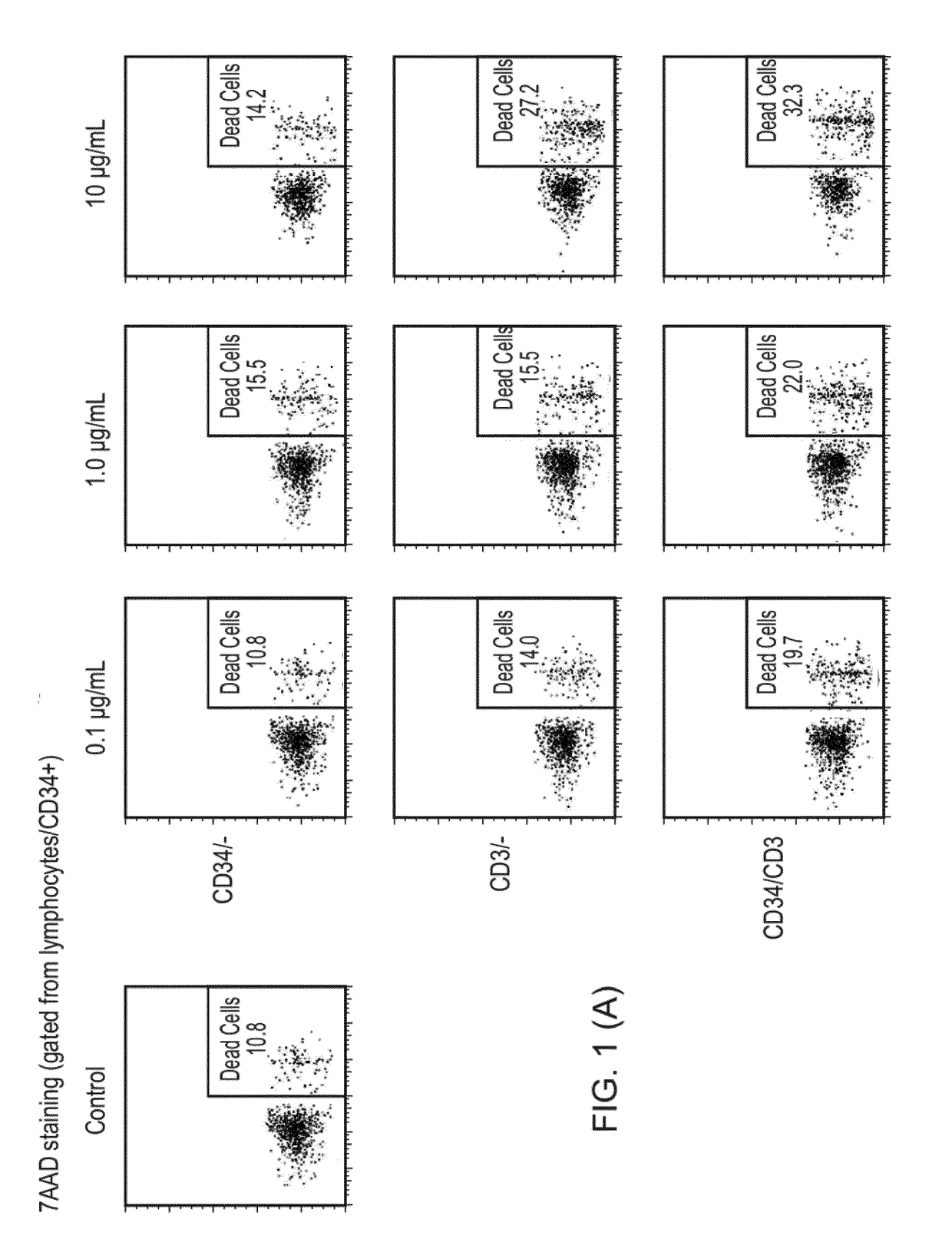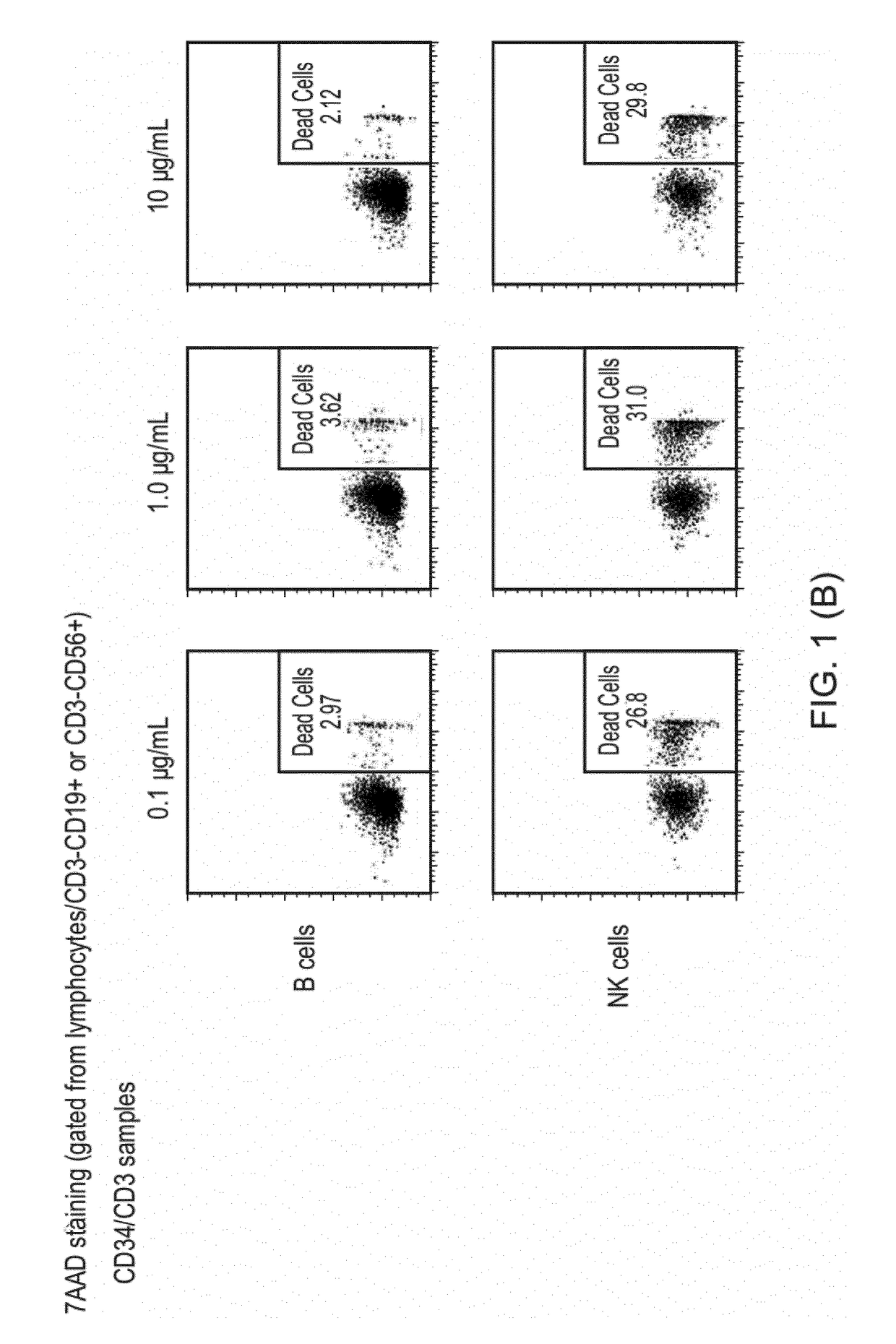Bispecific antibodies for use in stem cell transplantation
a stem cell transplantation and bior technology, applied in the field of bior multispecific antibodies, can solve the problems of disordered and ineffective hematopoiesis (blood production), many risks associated with such transplantation, and the quality of blood-forming cells is declining, so as to reduce the risk of recurrence, and improve the effect of survival ra
- Summary
- Abstract
- Description
- Claims
- Application Information
AI Technical Summary
Benefits of technology
Problems solved by technology
Method used
Image
Examples
example 1
[0396]A patient suffering from AML is about to undergo allogeneic HSCT. The patient is >70 years with fungal infection and has little chance to survive standard chemotherapy given as conditioning regimen. Before the transplantation the patient needs to undergo a preconditioning to minimize the risk of relapse due to survival of malignant cancer cells, minimize risk for rejection and make space for the new hematopoietic stem cells. In addition, the pre-conditioning will also influence the risk of GVHD. Instead of using the common methods of high dose chemotherapy and irradiation, the patient is treated with antibody-based immunotherapy using a CD34 / CD3 BiTE (e.g., the agent of Example 5, below) in combination with or without mild chemotherapy / radiation and with or without T-cell antibodies. This milder variant of pre-conditioning will likely reduce the risk of acute GVHD and the patient will have very little toxicity resulting from the treatment. Due to the target antigen of the anti...
example 2
[0397]A patient suffering from MDS has already received an allogeneic HSCT but has relapsed in the underlying malignant disease. The patient is eligible for a re-transplantation if the patient will be in hematological remission, i.e. no detection of malignant cells in the bone marrow. Patients considered for a re-transplantation are usually in much worse shape clinically than patients prior to primary HSCT. Instead of using the common methods of heavy chemotherapy as induction therapy, these patients greatly benefit from a milder and more efficient treatment in order to achieve remission. Before the re-transplantation the patient is treated with infusion(s) of a CD34 / CD3 BiTE (e.g., the agent of Example 5, below) with chemotherapy and with or without T-cell antibodies. This will minimize the risk of another relapse due to survival of malignant cancer cells, and minimize risk for GVHD.
example 3
[0398]A patient suffering from a non-malignant disease, e.g. Severe aplastic anemia (SAA), Wiskott Aldrich Syndrome, Hurlers Syndrome, FHL, CGD, Kostmanns syndrome, Severe immunodeficiency syndrome (SCID), other autoimmune disorders, inborn errors of metabolism or other immunodeficiencies, are eligible for a HSCT to exchange their non-functional hematopoietic cell compartment. Without treatment, the mortality rate for both of these conditions is extremely high. Before transplantation, a milder pretreatment compared to patients with malignant disease is used. While patients with non-malignant disease won't benefit from GVHD or GVL (Graft-versus-leukemia) (which could be beneficial in for example leukemia), an even milder pre-conditioning is warranted in non-malignant diseases. Instead of using conventional chemotherapy with or without irradiation the patient is instead pretreated with a CD34 / C3 specific BiTE (e.g., the agent of Example 5, below), T-cell antibodies and very mild chemo...
PUM
| Property | Measurement | Unit |
|---|---|---|
| Fraction | aaaaa | aaaaa |
| Fraction | aaaaa | aaaaa |
Abstract
Description
Claims
Application Information
 Login to View More
Login to View More - R&D
- Intellectual Property
- Life Sciences
- Materials
- Tech Scout
- Unparalleled Data Quality
- Higher Quality Content
- 60% Fewer Hallucinations
Browse by: Latest US Patents, China's latest patents, Technical Efficacy Thesaurus, Application Domain, Technology Topic, Popular Technical Reports.
© 2025 PatSnap. All rights reserved.Legal|Privacy policy|Modern Slavery Act Transparency Statement|Sitemap|About US| Contact US: help@patsnap.com


